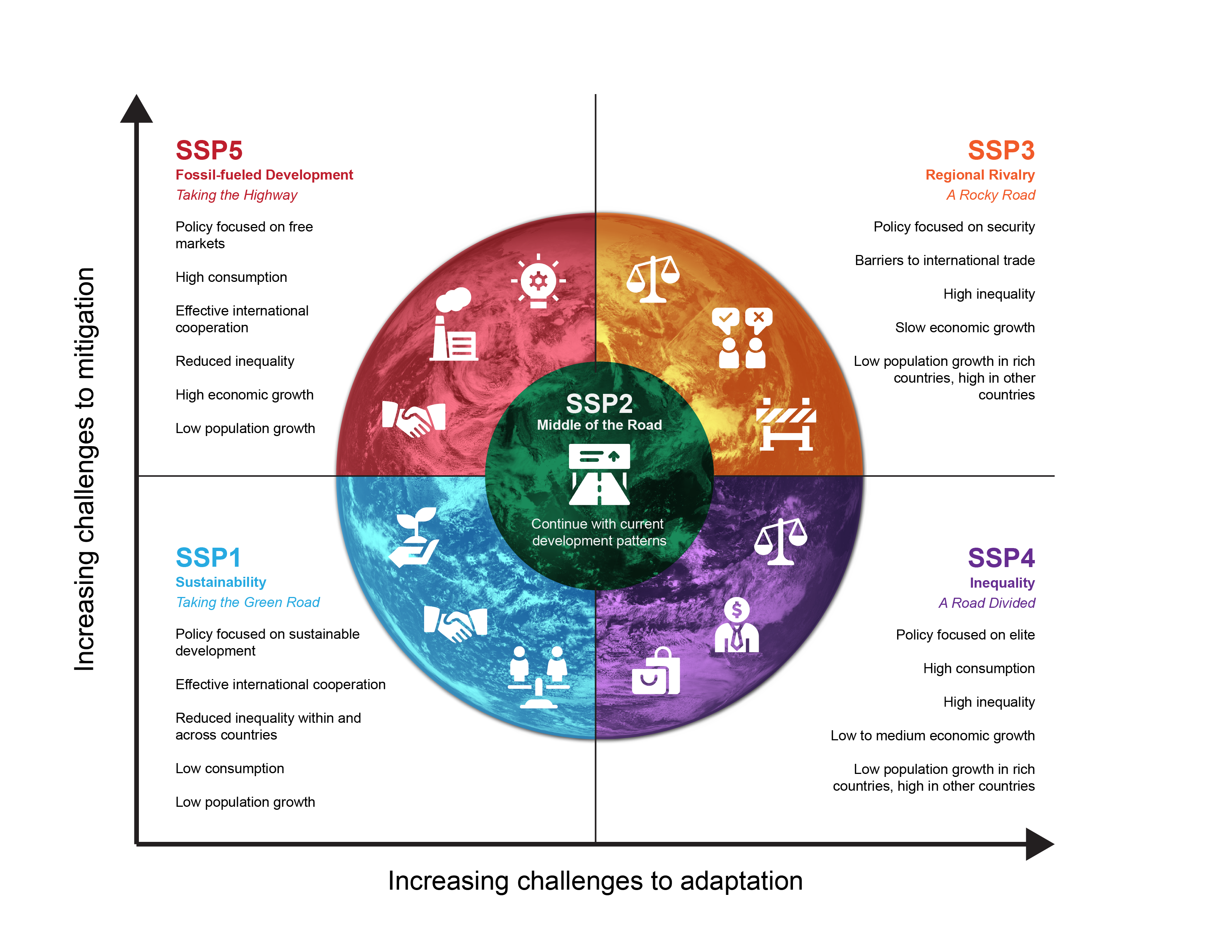
Have you ever wondered how policymakers make informed decisions for climate action? "That’s an easy one," you might say. "With science of course!" But even for scientists, understanding the world's climate is complex, and forecasting potential future developments is even more so. IIASA 2024 Science Communication Intern, Moritz Boeswirth explored this topic.
How do scientists forecast future scenarios? And how do they prepare their findings for policymakers? It's not so much "magic" or intuition as it is robust methods.
IIASA and the IPCC
IIASA has a long history of contributing to the Intergovernmental Panel for Climate Change (IPCC) whose main activity is the preparation of reports assessing the state of knowledge of climate change and to provide policymakers with regular scientific assessments on climate change, its implications, and potential future risks. As Edward Byers, a contributing author to the IPCC Sixth Assessment Report (AR6) in Working Group 3, explains:
"The IPCC doesn't actually run any specific models. They assess what exists in the scientific literature, so all the results and data that are assessed by authors come from a range of modeling teams around the world."
IIASA's many contributions to the IPCC can be described and best understood by looking at the Institute's past achievements in this regard.
One notable moment in IIASA's history was the "Carbon Dioxide, Climate, and Society" conference in 1978, which inspired the first IPCC Assessment Report. From the second report onwards, IIASA became a close collaborator to the IPCC to improve the stringency of climate change analysis. For AR6, 32 IIASA scientists actively contributed, either as review editors, contributing authors, or lead authors. In 2015, leading up to the release of AR6, IIASA organized an IPCC Scenario Expert workshop with 100 field experts. In addition, IIASA hosts the scenario explorer and databases that support IPCC assessments in Working Group 3.
Understanding current climate models and the Shared Socioeconomic Pathways
These past achievements show a close collaboration between IIASA scientists and the IPCC, but how does this collaboration actually work?
Let's begin with a simple overview of the most prominent forecasting scenarios in the IPCC AR6 Report. There are five scenarios, or so-called Shared Socioeconomic Pathways (SSPs), ranging from "the road to sustainability" to "taking the highway" (see figure below). With current policies, humanity is on the way to reach 2.7°C, which is closest associated with SSP2-4.5 – the "middle of the road" scenario. Imagine this "middle of the road scenario" as a more likely outcome based on past developments and moderate societal transformations.
In qualitative terms, the storyline is described as follows: “SSP2 does not imply a simple extrapolation of recent experience, but rather a development pathway that is consistent with typical patterns of historical experience observed over the past century. For example, emerging economies grow relatively quickly and then slow as incomes reach higher levels, the demographic transition occurs at average rates as societies develop, and technological progress continues without major slowdowns or accelerations.” (Full storyline)
The main qualitative elements of SSP2 are comprised of stable economies worldwide, however, with uneven income growth distribution. Progress on achieving the Sustainable Development Goals has been slow and global dependency on fossil fuels remains. Global population growth tapers off but not rapidly, as major improvements in education, which usually lead to less children per woman, are absent.
In sum, in this scenario, the world is facing moderate challenges to climate mitigation and adaptation. Note that SSP2 is not regarded in isolation. For example, the “middle of the road” SSP2 narrative is characterized by a fairly balanced view of progress for both conventional fossil- and non-fossil fuel technologies. In this sense, technological development in SSP2 is not biased toward any particular technology group. You can also see this scenario reflected in current policy discussions, like the EU’s approach to different fuels competing with electric vehicles. It is important to note that to fully grasp and understand the SSPs and the differences between them, the five pathways cannot be regarded in isolation and need to be analyzed jointly. That goes beyond the scope of this piece, but we want to shed light on the quantification process based on this SSP2 example.
The Integrated Assessment Modeling Framework
Building on the above, IIASA set out to work with this scenario, and use its own modeling tools to describe it in quantitative terms. The quantifying work by IIASA is done within an Integrated Assessment Modeling (IAM) framework, MESSAGEix-GLOBIOM, and aims to describe the middle of the road scenario of SSP2 using numbers.
The IAM Model includes five main areas: the energy system, the land-use system, air pollution, macro-economic systems, and the climate system. These quantitative models predate the IPCC assessments and are adapted for use in these evaluations. IIASA is currently hosting the secretariat of the IAM Consortium. For more detailed information, please visit the IAMC's official website.
The graphic above shows the interconnectedness of research models that is typical within IAMs, including MESSAGEix-GLOBIOM. The framework consists of different subgroups, analyzing different aspects of climate modeling, for example, using the Greenhouse Gas and Air Pollution Interactions and Synergies (GAINS) model for air pollution scenario modeling. They are regional to global in their reach and universally applicable through transparent methodology and rigorous quantification.
Zooming in on one particular assessment model, the IIASA Global Biosphere Management Model (GLOBIOM), which was initially released in 2008, is used for analyzing competition for land use on a global scale. It does so by capturing the complex interactions between the agricultural, bioenergy, and forestry sectors using data such as methane emissions from rice cultivation, and assessing the impact of various policies and market conditions on land use, food security, greenhouse gas emissions, and biodiversity.
A range of modeling teams across the world implemented the set of SSP scenarios, with the IIASA MESSAGEix-GLOBIOM run chosen after much analysis, to be the marker scenario for SSP2. For each of the five SSPs, a different model was used for quantification. IPCC authors compare and contrast different existing models in order to understand scenario and modeling uncertainties. Every scientist has access to these peer-reviewed publications and calculations, which improves legitimacy and establishes a sound, updatable framework rather than opinionated and emotionally loaded appeals.
Science communication to policymakers
Once the scientific analysis of an issue has been done, it's important to share the findings with policymakers. The latest report – AR6 – is frequently used by policymakers to inform their decisions around climate policy. In addition, the report received broad media coverage upon its release and was prominently used as direct and critical scientific input to the Conference of the Parties (COP), the decision-making body of the United Nations Framework Convention on Climate Change (UNFCCC).
So, in summary, assessing climate change and its potential future risks and developments is done using modeling techniques from different research institutes around the world. IIASA is an important contributor to the IPCC and more specifically, with the IAM framework, to the SSPs Scenarios. These findings are not standalone scientific publications, but have wide-ranging policy implications and are used as boundary objects in discussions of the UNFCCC or similar conferences and decision-making processes. While this piece does not aim to provide a deep dive into the quantification processes like the IAM for example, I encourage everyone to learn more about these processes using the links provided.
My broad overview hopefully inspired some trust in the scientific method and in the work done at IIASA on a daily basis. Whether this type of engagement and structural context of science-policy collaboration is however enough to combat climate change effectively is question for another day.
Note: This article gives the views of the author, and not the position of the IIASA blog, nor of the International Institute for Applied Systems Analysis.

